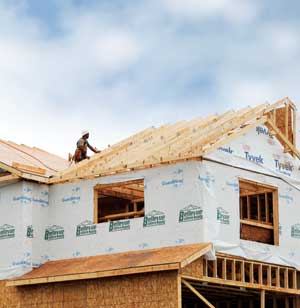Survival Tactics
Sometimes, though, dealers can’t avoid extending their installation services to remodeling when their builder clients have made that detour themselves. Virtually all of Burton Lumber & Hardware’s customers are new-home contractors, and this Salt Lake City-based dealer’s six locations generate about 25% of their annual revenue from installed sales. Many of the builders that these contractors work for have migrated to remodeling as a survival strategy.
“Our mix of remodeling [installs] is higher than it might have been, but we don’t go after that business ourselves,” says operations director Mark Burton.
Other dealers accept remodeling assignments, albeit cautiously. For example, one of the first questions Granger, Ind.-based Big C Lumber asks a homeowner requesting installation is whether he or she has spoken with a contractor. “If they have, we’ll turn down the job,” says Bill Wallace, Big C’s chief operating officer.
84 Lumber, which says installed sales represented 15% of its 2010 revenue, in select markets installs exterior components like roofing, siding, and some insulation for remodeling projects. It avoids pushback from contractor customers because its yards are “very controlled” about the remodeling jobs they’ll handle, explains Mike McCrobie, 84’s vice president of installation and manufacturing. “We typically get into remodeling when there’s a contractor void in the market” or when a unique opportunity presents itself, he says, like existing-home weatherization financed by the federal government.
Because most industry watchers don’t foresee any sustained housing recovery until 2013 at the earliest, pro dealers hesitate when asked if their installation services are or will be profit centers.
Among the mitigating factors is a bidding process that “has become a numbers game,” observes Rhonda Millick, chief financial officer for Franklin Building Supply in Boise, Idaho, which generates 15% of its revenue from installed sales, all of it from new construction. “It’s been price sensitive for several years, and I don’t know how you get around that other than accept lower margins.”
Gaskell at Bellevue Builders notes that margins are more precarious because builders are seeking more bids. And Mark Burton–whose company provides installation for about 40% of the projects it supplies–says that more builders want deals on both materials and labor, “even though there hasn’t been a lot of [price] contraction on the supply side.”
Consequently, dealers such as Big C and Home Lumber & Décor in Junction City, Kan., view installation primarily as a customer service and less as a growth vehicle. “We make a few bucks from the service, but it’s more of an alternative for our customers,” says John Talarico, Home Lumber’s sales manager.
That said, Talarico notes that his company–whose installed sales program has benefited in recent years from a homebuilding and remodeling boom related to the massive expansion of nearby Fort Riley–can sell up to 20% more product to a client for which it also provides installation.
Expanding the Value
Mike Mahre, senior vice president of corporate development at ProBuild, thinks the trick to making money from installation services will be “to get beyond offering it as a necessary service to sell products, and extending it beyond labor brokering–which is what’s going on right now–to areas like time- and cost-saving, waste reduction, and risk mitigation, so that it’s a larger value proposition.” To that end, Denver-based ProBuild, with roughly 450 locations nationwide, is developing a “best practices” approach to management and installation, which Mahre says is close to being rolled out.
Dealers with in-house manufacturing, such as roof-truss or wall-panel facilities, are leveraging those capacities when they bid for installation jobs. ProBuild, for one, operates 80 component and millwork plants that Mahre says create value by “enabling control of production schedules.” Tolly of Builders FirstSource agrees that manufacturing gives his company’s yards an edge by helping builders reduce waste and provide just-in-time delivery to jobsites that may have limited material storage areas.
Both Franklin Building Supply and 84 Lumber see growth opportunities coming from, in McCrobie’s words, “getting more installation out of each housing start,” meaning that builders would use their services for more than one or two construction stages. 84 also likes the immediate prospects for multifamily and light commercial projects, in which its stores have gotten more involved lately. Any job larger than 30,000 square feet now falls under 84’s two-year-old Commercial Sales Division.
But as the construction sector remains fragile, dealers aren’t automatically leaping into every project that crosses their paths anymore. “We’re spending more time pre-qualifying opportunities,” says McCrobie, “to make sure they are financed properly and would be right for 84 Lumber to work with.”

